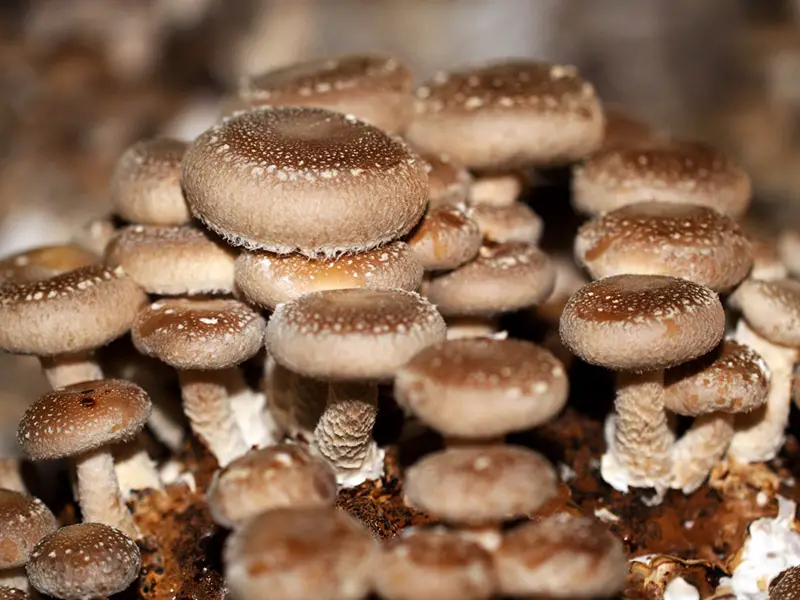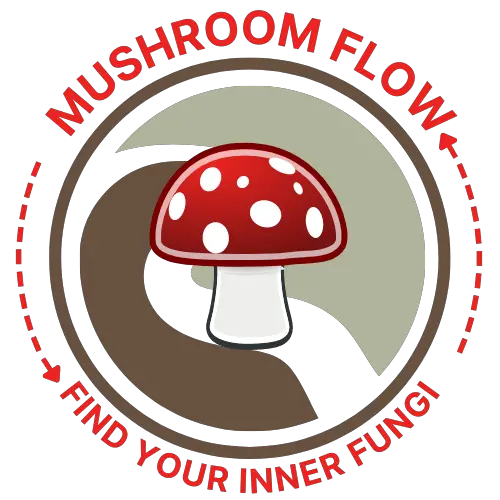Origins of the Shiitake Mushroom
Shiitake mushrooms come from the Far East, where they grow on hardwood trees, specifically the Shii tree, which is how they got their name. Humans learned to cultivate shiitake mushrooms by sticking logs near dead wood that hosted wild mushrooms in hopes that the fungi would pass from the old wood to the new wood.
Flash forward to today, when I have a ton of straw leftover from growing my oyster mushrooms. I started wondering, can shiitake also grow on straw?
There are a few shiitake mushroom strains that can be grown on straw. However, it isn’t recommended by most mycologists, who prefer to use wood substrates that replicate how shiitakes grow in nature.

Can Shiitake Mushrooms be Grown on Straw?
Mushrooms have many varieties and the same variety of mushrooms can vary. So, if you have spores from two different shiitake mushrooms they can be from two different strands and produced at different times or prefer different substrates.
Why are we going through all of this? Because shiitake mushrooms do have some strands that can be grown on straw, but in general, they tend to struggle on straw compared to oyster mushrooms. Shiitake prefer substrates that are wood-based, like logs or sawdust.
Pros and Cons Growing Shiitakes on Straw
With all of that in mind, let us dig a little deeper into the pros and cons of growing shiitakes on straw.
Pros:
- Straw is a more renewable substrate than wood. While we can grow wood, it takes a lot more time than cereal straw to mature and harvest.
- Sometimes straw is easier and cheaper to come by than the right kind of wood.
- Straw tends to be more aerated and less prone to compaction. In addition, it can carry a lot of moisture, a bonus for nurturing mushrooms.
- Straw tends to be less nutritious meaning less competition from other fungi and bacteria.
Cons:
- The process to sterilize and add more nutrients to straw can be tedious and difficult.
- Shiitake strains have difficulty growing on non-wood substrates.
How to Prepare Straw for Mushroom Cultivation
Well, if you have made it this far then you are probably determined to grow shiitake mushrooms on straw. Your enthusiasm is great! Any good mushroom grower needs a high level of positive energy.
There are two different ways to prepare the straw, depending on the way you want to grow your mushrooms. You can either grow them on plain straw (not recommended) or you can grow your mushrooms on straw that has been nutrient-enriched (recommended). For either method, the straw should be chopped up into pieces about 2-3 inches in length.
Pure straw
With pure straw, you really only need to pasteurize instead of fully sterilize. Pasteurization is a heat treatment that is meant to kill organisms that compete directly with mycelium.
You can pasteurize your straw by cooking it in water that is 160 degrees F. You will keep the straw submerged for at least 12 hours in the hot water. You can do this in a large cooking pot, or if you would like to do bulk pasteurization it can be done in a metal drum.
Whether you use a smaller or larger container, it is important to ensure that the container has never been used to hold harmful chemicals. Mushroom mycelium can be very sensitive, and the last thing we want to do is accidentally kill them before they have a chance to mature.
Once you are done cooking the straw, you should let it drain in a clean area and then spread it across a disinfected surface to cool faster. After cooling, mix the mushroom spawn into the straw, place it in your myco bag and seal it. Then let out a sigh of relief! You can now wait for your mycelium to colonize the straw!
Supplemented Straw
Supplementing straw can be quite a hassle, but may give your shiitake mushrooms a better chance of survival. The following formula developed by Paul Stamets is used to give a nitrogen boost to your mushroom buddies. It requires:
- 85 parts chopped straw (other agriculture by-products can be used as well such as ground corn cobs)
- 10 parts rice bran
- 4 parts gypsum
- 1 part calcium carbonate.
You will also add water to get the mixture to field capacity, or basically wet but not soaking wet. If the mixture is too wet then water build-up may cause contamination.
After you have your ingredients mixed together, place them in breathable myco bags and temporarily tape them shut. To sterilize the supplemented straw you will need a pressure cooker. Place your bags into the pressure cooker, trying to give them each enough space to heat well, and then cook the bags for 2-3 hours at 15 psi.
Allow the bags to cool when they are done cooking, and then inoculate them with your grain spawn and seal them.
For both methods, when you start to see the mycelium changing from a white to a brown color you will know that it is ready to fruit. For your first flush, you will want to put the bags into an area that has 90% humidity and make a slit for the pins to pop out of. You want to try to keep the number of mushrooms to about 12 by introducing them to fresh air before more pins form. This keeps your shiitakes nice and large.
Final Thoughts
Even though many wood-loving species of mushrooms are ready to make the switch from wood to straw, shiitake mushrooms find it more challenging. Being able to grow shiitake mushrooms on straw would be beneficial since straw is cheaper and more available than logs or sawdust. Plus, straw has fewer bacteria and fungi that want to eat it, making it a better substrate for beginners.
If you are feeling adventurous, go ahead and give straw a try with shiitake mushrooms. In the end, whichever substrate you chose, I wish you the best on your wonderful, mushroom-growing adventures!
